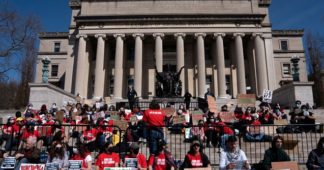The ripple effects will be felt around the country. Roughly 80% of federal workers live outside the Washington area, and government services — patent approvals, food inspections, park maintenance and more — could be hindered depending on how cuts are handled.
Resistance is expected. Labor unions, Democratic state leaders and other organizations have tried, with some success, to slow Trump down with litigation, while Republicans are growing more concerned about how a slash-and-burn strategy could affect their constituents.
“Once you do this damage, it’s going to be incredibly hard to rebuild the capacity of these organizations,” said Don Moynihan, a public policy professor at the University of Michigan. “It’s not like you can turn the switch back on and everything is going to be the way it was before.
Agencies are directed to submit by March 13 their plans for what is known as a reduction in force, which would not only lay off employees but eliminate the position altogether. The result could be extensive changes in how government functions.
No specific targets for cutbacks were included in the memo. However, as an example, Trump said the Environmental Protection Agency could reduce its staff by 65%.
A White House spokeswoman later clarified that the 65% figure referred to budget cuts at the agency, rather than staffing levels. EPA Administrator Lee Zeldin “is committed to eliminating 65% of the EPA’s wasteful spending,” spokeswoman Taylor Rogers said Thursday.
More plans are due on April 14, when agencies are expected to outline how they will consolidate management, become more efficient and potentially relocate offices to parts of the country that are less expensive than Washington. The memo said agencies have a Sept. 30 deadline for implementation.
Administration officials framed their effort as a cost-saving measure with a clear ideological goal.
“The federal government is costly, inefficient, and deeply in debt. At the same time, it is not producing results for the American public,” said the memo from Russell Vought, director of the White House’s Office of Management and Budget, and Charles Ezell, acting director of the Office of Personnel Management, which functions as a human resources agency. “Instead, tax dollars are being siphoned off to fund unproductive and unnecessary programs that benefit radical interest groups while hurting hard-working American citizens.”
Vought was an author of Project 2025, a conservative blueprint for Trump’s second term, and he has advocated for centralizing power under the presidency and dismantling federal bureaucracy.
“We’re not going to save our country without a little confrontation,” Vought said last summer during a podcast hosted by Trump ally Stephen Bannon.
We remind our readers that publishing articles on our site does not mean we endorse their content. Our policy is to publish anything we find interesting, to help readers form their own opinions. We sometimes publish articles we strongly disagree with, as we believe it’s important for readers to be exposed to the widest possible range of viewpoints.











